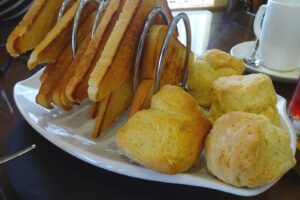
Courtesy Benreis at Wikimedia, GNU Free Documentation License
I started to say there is no bad toast—a simple enough sentiment but simply wrong. Simple, it turns out, is often difficult, and mere simplifications are lies.
Good toast is twice-baked to the right degree both times, twice-realized, twice-perfected. Art, craft, ingredients, and timing go into it, and the process starts with a farmer in a wheat field, sometimes years earlier.
But no snobbery for the staff of life: My favorite toast is made with Walmart’s Italian bread baked in-store and sold (until recent inflation) at 99 cents a loaf, though it is large and already contains the cost of slicing. A local restaurant that passes for fine dining in my town uses it exclusively for their complimentary bread baskets. I toast the bread in my Walmart toaster. I paid less than $10 for it, but it does not lift the toast high enough at the end. For four years I used a knife or my fingers to get it out, often getting burned and yanking at it with a volley of cussing, so the slice fell into the dish drainer or even the other well of the toaster, where I had to twice risk electrocution or a burn. Bamboo toast tongs have made my life better since Christmas.
When I want to live more wildly, I pick up the supermarket bakery multigrain with wheat and barley flour, oats, barley flakes, corn meal, millet, molasses, honey, and sesame, sunflower, flax, and pumpkin seeds. To have it sliced before I leave the store, the loaf must be removed from its plastic bag and put in a box with a plexiglass lid, where metal claws grip it and a terrifying, automated buzz saw cuts it thin, medium, or thick. When the lights flash, I have to put my hands to the elbow in the saw enclosure, lift the sliced loaf out, holding it together, and set it on a kind of speculum to get the bag back over it. Putting butter and jelly on toasted slices of that bread is like preparing something too rich and contradictory after danger and inconvenience—like melting a thick slab of cheddar cheese onto apple pie after running a red light and being stopped by the police.
The Brits use toast racks, a civilized device I would never own, which prevents toasted slices from steaming. Compare toast in most American diners, slathered with so much fake butter it reverts back not just to untoasted bread but to oily dough. Two slices like a sandwich with nothing in it are cut on the diagonal, and their edges sop in the broken yolks on the plate.
As with all seemingly simple pleasures, you have to be present to appreciate toast. One day last week I got out the bread, the butter, the jelly, the knife, the plate. I paced my living room, preoccupied thinking about something else, soup maybe, and impatient for my toast to pop up so I could get on with my day. When I went to check the toaster, it was empty. I call that ghost toast, but it is not the recipe I want to share.
Recipe
Take your preferred bread and toast the slices to the darkness you like. I prefer starting to burn at the edges. You can let it dry a bit longer by leaving it in the toaster after it is done, if you can wait. Tent the two slices on a plate to cool, so they do not lie in their own moisture.
Butter with your preferred butter—a lot of it, whether real Irish or fake tublet.
Apply honey, jelly, jam, or marmalade. I prefer the plastic squeeze dispenser of strawberry jam, which tastes like tiny mountain wild berries harvested from an alpine meadow. Do not fall for the low-sugar version; I tried that. Or be a purist: do not use sweet coverings at all.
Ideally, the toast should be a little warmer than your mouth, the butter neutral, and the jam still cold. Enjoy the crunch of its collapse, the aroma of something that should be simple but is not. Our knowledge comes to us in crumbs.
Look out through the cat-ruined blinds, the window with fake muntins, the summer screen pulsing in the wind driving the snowfall. There is more hot coffee in the pot, more bread and butter and jam, things feel good.
Everybody is off on some trip. Get real. Make toast.
